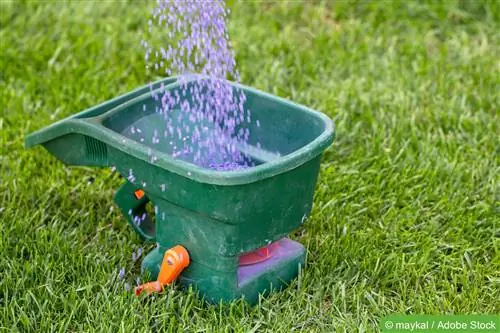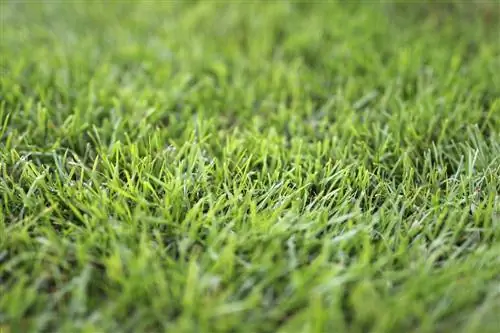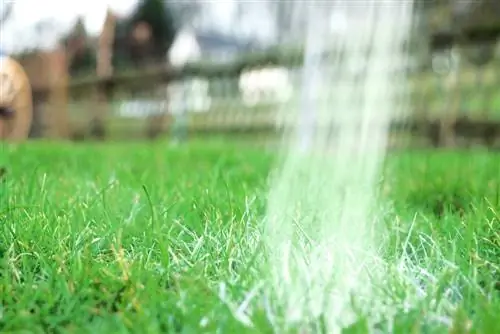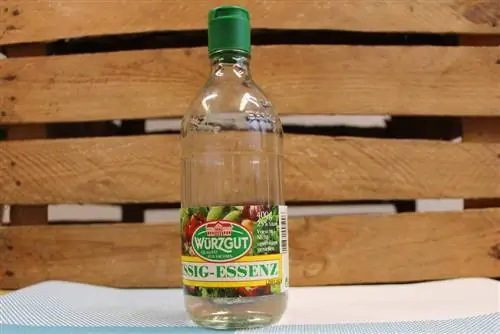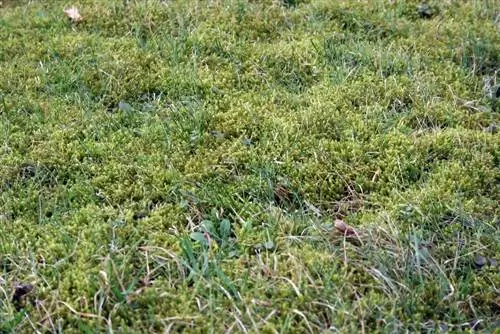- Author admin [email protected].
- Public 2023-12-17 03:39.
- Last modified 2025-01-24 12:45.
An even, lush green lawn is always the result of a holistic care program based on a balanced supply of nutrients. All too often, stubborn weeds and moss thwart the aspiring hobby gardener's plans. Read here how you can still achieve the goal of an even green area with the help of combination preparations as lawn fertilizer with weed killer and moss killer. Practical tips for effective prevention against stubborn dandelions, penetrating speedwell, unsightly moss and other adversities pave the way to a perfect lawn, as if woven by hand.
Innovative combination preparation solves circular reference
In their search for a lawn fertilizer that also destroys weeds and moss, hobby gardeners have so far looked in vain. The reason for the manufacturers' reluctance is that weeds prefer to attack soil with a slightly alkaline pH value, while moss is attracted by an acidic pH value. The entire control plan for weeds and moss in the lawn is based on regulating the soil acid value. A well-known manufacturer of numerous proven products for garden and lawn care managed to break this circular relationship. The first combination preparation is available on the market under the name Compo Floranid lawn fertilizer against weeds and moss 4 in 1. Given the short time frame, there is still a lack of solid experience as to the extent to which the problem will actually be solved. At least the concept is convincing.
Composition:
- Lawn fertilizer with NK (MgO) formula 14+6+3 with a long-term effect of 3 months
- 1, 6 g per kg Dicamba as a herbicide against dicotyledonous weeds
- 3, 6 g per kg 2, 4-dichlorophenoxyacetic acid as a special herbicide against common lawn weeds
- Iron II sulfate to combat moss
The preparation is administered once a year between May and August at a dosage of 30 g per square meter. The high-priced product costs a whopping 55 euros for a 300 square meter lawn to enjoy an even lawn for 3 months. However, the product is less suitable as an autumn fertilizer due to the relatively low potassium content.
Effective prevention in the service of nature
Looking at the composition of the combination preparation, it is clear that the manufacturer has reached deep into the chemical bag of tricks. The mineral lawn fertilizer is spiced up with 3 supplements that have conservationists throwing their hands up over their heads.2,4-Dichlorophenoxyacetic acid was already used as a defoliant during the Vietnam War and is still one of the most common weed killers worldwide after glyphosate and atrazine. The same applies to dicamba, which is usually combined with 2, 4-D. As if that weren't enough, any moss that has been destroyed with the help of iron II sulfate is classified as hazardous waste. If you prefer not to use this concentrated load of chemicals on your lawn, follow the following care program. The slightly higher effort is rewarded with a he althy lawn that vehemently stands up to weeds and moss as well as the good conscience of a sparkling clean personal environmental balance.
Professional mowing
The more regularly you mow the lawn, the more the blades of grass get used to the optimal cutting line. The result is a robust scar density, which results in excellent photosynthesis capacity. Such a green space can easily cope with stress of any kind. The one-third rule has proven to be a good rule of thumb for the ideal cutting height. This means that a maximum of a third of the stalk height is cut per mowing pass. The frequency depends on the type of lawn being cultivated, the location and the seed mixture used. The following guidelines may serve as your guide:
- High-quality ornamental lawn: mow every 7 days
- Sports and play turf: twice a week in summer
- Shadow lawn: Cut every 10-12 days
After the first cut of the year leaves the grass 80 to 100 mm high, over the course of the summer season the ideal blade height levels off at 35-45 mm for ornamental and sports lawns and at 70-75 mm for Shadow lawn. During periods of drought, leave the noble grasses 10-15 mm higher for better moisture balance.
Tip:
A green area that is to be mowed should not be entered beforehand. Weeds and moss that have been trampled down only stand up again after the mowing cycle and continue to shoot upwards. Consistent mowing will of course weaken seed and spore weeds in the long term so that they begin to retreat.
Balanced fertilization
So that your lawn is prepared to compete with weeds and moss, it must not lack nutrients. So that the noble grasses do not suffer from deficiency symptoms, fertilize as follows:
- Provide lawn grasses with a growth advantage in spring with short-acting lime ammonium nitrate
- Administer a mineral-organic long-term fertilizer in April/May with an effect of 3 months
- Apply a potassium-focused autumn fertilizer in July/August or apply patent potassium
For the naturally managed garden, purely organic lawn fertilizers from specialist retailers can be considered as an alternative. You can optionally fertilize your green area in March, May, August and October with finely sifted compost, horn shavings and plant manure. It should be borne in mind that organic fertilizers must first be processed by the soil organisms in such a way that the nutrients are available to the lawn grasses. If your green business card is already under siege by weeds and moss, a combination of mineral and organic fertilizers comes into focus, such as a fast-acting nitrogen fertilizer (KAS) and subsequent organic lawn fertilization. The shock growth suppresses weeds and moss early and effectively until the natural nutrients are available to the grasses.
Fighting weeds and moss
Although a well-considered care program makes life difficult for weeds and moss, dandelions, speedwell, horsetail, clover and moss still occasionally spread. The sooner you counteract an infestation, the quicker you will get rid of the plague. The following tips present tried-and-tested approaches:
Verticutting
When temperatures are well above 10 degrees Celsius in spring, it is the best time to comb out weeds and moss. Scarifiers can be rented for one day at a reasonable price from a garden center or hardware store. The device uses rotating blades to remove any unwanted thatch from the turf. Choose a dry, overcast day in March/April to follow these steps.
- Mow the lawn as deep as possible
- Treat the green area with the scarifier in a checkerboard pattern
- Rake up the combed out plant material and dispose of it in the compost
After regeneration of 8-14 days, apply the selected lawn fertilizer. In the following days the greenery is watered repeatedly and extensively.
Lime against moss
If moss dominates the lawn, this dilemma indicates that the pH value is too low. If a test kit from the garden center confirms your suspicion, you won't be able to get rid of the thatch with scarifying and fertilizing alone. By regulating the soil acidity with lime, you permanently deprive the moss of its livelihood. After combing out and before applying lawn fertilizer, the green area is limed. The determined pH value and the soil condition define the exact dose. After the lime has been spread with the spreader, sprinkle the lawn extensively. We recommend waiting 3-4 weeks before using the lawn fertilizer so that the preparations do not interfere with each other's effectiveness.
Fighting weeds manually
If you resist the beginnings, you can save yourself the trouble of using a chemical weed killer on your lawn. Regular mowing permanently depletes seed weeds. To put a stop to other weeds, we have put together the following tips for you:
- Pull out individual root weeds with the weed cutter or by hand
- Fight dandelions with repeated sprinkling of pure charcoal ash
- Water deep root weeds with boiling water, pull them out and close the gap with lawn seeds
- Cut off thistles shortly before watering the lawn so that rain falls into the hollow stems and they rot
- Close gaps in the lawn after the scarifier with turbo reseeding before weeds and moss do it
Spotually weedy patches of lawn can be cut off with a spade and lifted out. Lawn paving and rolled turf segments are available from specialist retailers to close the gaps with vital noble grasses within a short time.
Tip:
Don't spend too much time dealing with a hopelessly weedy and mossy lawn. Using the rolled turf sandwich method, you can transform the battered green area into a fresh green carpet within a day. This also saves the high effort of a completely new system.
Conclusion
An even lawn carpet is not given to anyone, but needs to be actively achieved with a well-balanced care program. If, despite all efforts, the green area is defaced by penetrating weeds and moss, lawn fertilizers with weed killers and moss killers provide temporary relief. In order to get rid of the problem in the long term or to avoid being confronted with it in the first place, a sophisticated package of preventive measures is important. This includes professional mowing, as well as annual scarifying, well-dosed mineral or organic fertilizing and liming. In the early stages of infestation, manual control methods are so effective at stopping weeds and moss that resort to costly chemical preparations takes a back seat.

